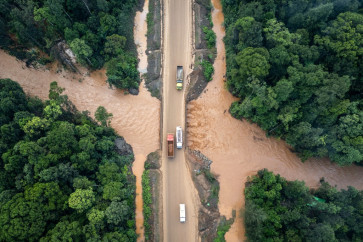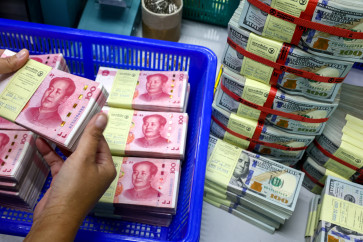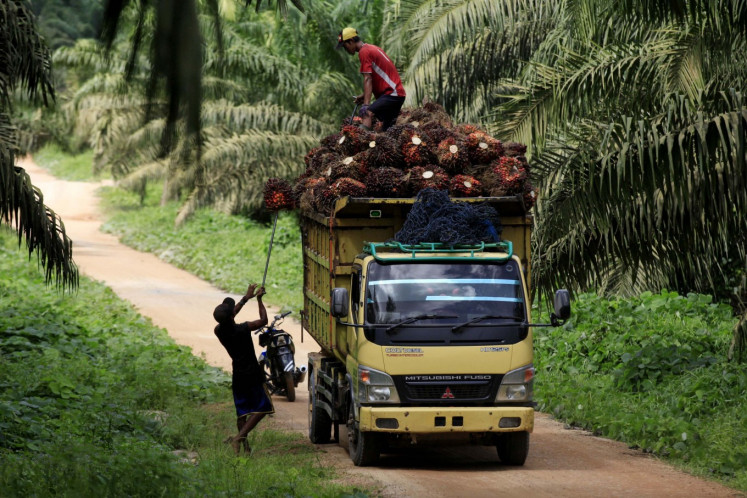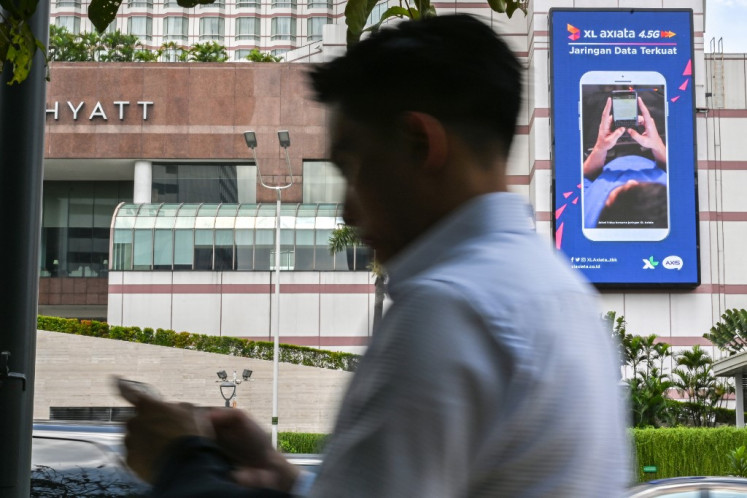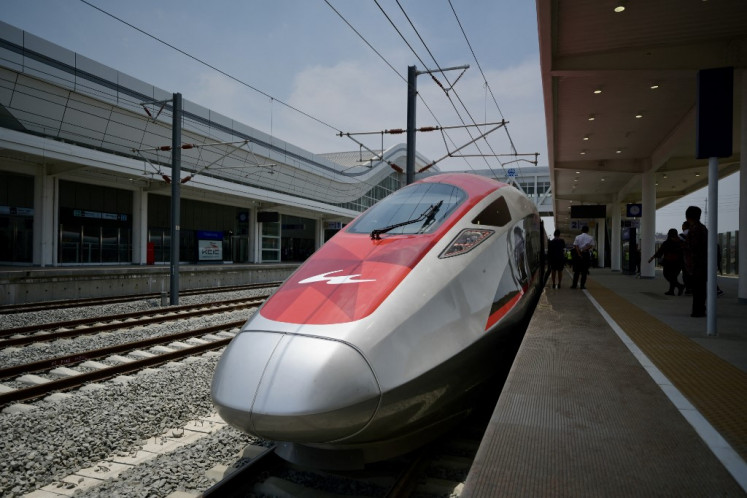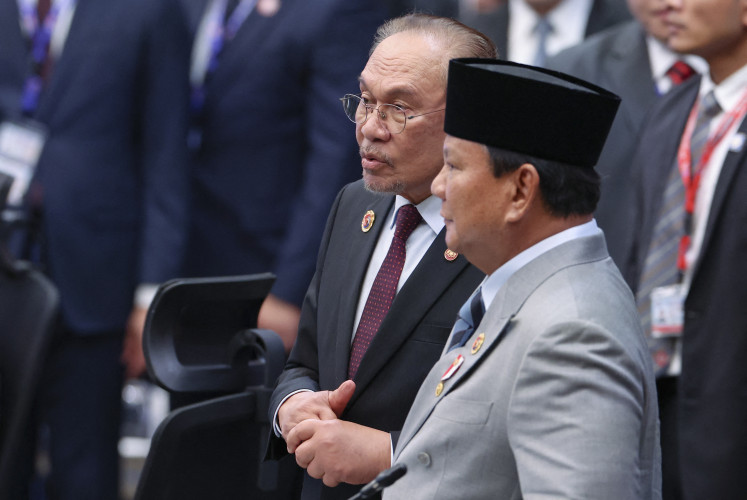Popular Reads
Top Results
Can't find what you're looking for?
View all search resultsPopular Reads
Top Results
Can't find what you're looking for?
View all search resultsJapan, ASEAN after 40 years
After 40 years of relations, Japan and ASEAN have mutually become one of the most important trading partners
Change text size
Gift Premium Articles
to Anyone
A
fter 40 years of relations, Japan and ASEAN have mutually become one of the most important trading partners. There are about 7,000 Japanese companies operating in the region. According to research, eight ASEAN countries appear on Japanese companies’ list of the 20 most favorable investment destinations in years to come.
The greatest asset of 40 years of cooperation is, however, the bond molded between the people of ASEAN and Japan through the exchange of people, especially the youth. The number of ASEAN students who are studying in Japanese universities has steadily increased to more than 13,000 per year.
Under the Japan-East Asia Network of Exchange for Students and Youth (JENESYS) program, launched by the then prime minister Abe in 2007, more than 14,000 young people of Japan and ASEAN visited each other. At the beginning of his second reign as prime minister, Abe announced the launch of JENESYS 2.0, which aims at bringing 30,000 more youths in ASEAN and other Asian nations to Japan.
It will be most suitable to call our relationship “a strategic partnership”, a relationship that shares common strategic interests and objectives. Japan’s economic growth is closely intertwined with that of ASEAN.
As the indispensable sea lanes for Japan pass through the region, ASEAN’s stability is essential to Japan’s peace and prosperity. Furthermore, it is critically important both for ASEAN and Japan to work together for the realization of regional architectures that underpin peace and prosperity in Asia Pacific.
How should Japan and ASEAN shape their strategic partnership for the future? Abe has proposed “five Principles”: (1) protection of universal values (freedom of expression etc.); (2) rule of law; (3) free and open economic network; (4) cultural exchange; and (5) exchange of younger generation.
Needless to say, ASEAN decides which path to take as the driver at the wheel (ASEAN centrality). But the driver should also obey traffic regulations as mentioned in principles 1 and 2. Some say it is too value-centric, but both principles are already agreed by ASEAN member states and enshrined in the ASEAN Charter. The latter three principles correspond to ASEAN endeavors to strengthen connectivity. These are the principles, as you see, for Japan to walk together with ASEAN.
I would like to add two comments regarding the “five Principles”. The first is about the importance of the Japan-US alliance. The US has long been the main provider for the public domain: security, of which all countries in the region are beneficiaries. In the foreseeable future, no other country will completely replace the role played by the US. We need to work together in nurturing this public commonality. Deepening the Japan-US alliance should be understood in this context.
Second, some say that the five principles are aimed at containing China. No way. The growing China offers great opportunities for all of us. There remains, however, uncertainties or ambiguities, as to what kind of role China intends to play or what kind of responsibilities it wants to shoulder in the region as a big power, that sometimes lead to “concerns”. This challenge has to be addressed, not by containment but by searching for common ground through partnership, with ASEAN playing a pivotal role.
The most urgent challenge in the region is how to maintain peace and stability in the ocean. Freedom of navigation is a prerequisite for the prosperity of all countries in the Asia Pacific region. Differences of opinion over particular territorial issues should be managed and solved by the parties concerned. However, realization of rule of law at sea and the effort to find a peaceful solution to problems or management of issues are of crucial interest to all nations. Should there be any violation or acts to the contrary, all of us must raise our voices to overcome them.
Since the Japanese economy has stagnated for a long period, some say Japan’s role in the region is
fading away. Is that true?
In a world of globalization, it is natural to see many other countries come to play greater roles with ASEAN. Cooperation and competition under agreed and transparent rules can generate competitive edges of respective players.
Connectivity and disaster management, for example, are areas where Japan excels. With supply chains that are spread throughout the region, Japanese companies share common interests with ASEAN in connectivity enhancement within and beyond ASEAN. Japanese businessmen in the region are facing various challenges related to connectivity.
Immediately after ASEAN announced the Master Plan on ASEAN Connectivity in 2010, Japan set up a task force consisting of public and private sectors, which has been working side by side with ASEAN to strengthen connectivity. Various projects of physical and institutional connectivity are being implemented. The economic corridors in Mekong are gradually taking shape. Maritime corridors will soon follow.
While human capacity empowerment is a prerequisite for connectivity to deliver its dividends, many Japanese companies and governmental organizations are conducting various kinds of capacity building projects, transmitting Japanese mono tsukuri (manufacturing) spirit to the region.
Then again, let us not forget that Japan’s stagnation will not last forever. “The sun also rises.”
Japan is a natural-disaster-prone country and thus has ample experience and knowledge in this area to share with ASEAN. In addition to most of the assistance that is provided under a bilateral scheme, we have started cooperation with the AHA Center (ASEAN Coordinating Center for Humanitarian Assistance on disaster mangement) in Jakarta, which plays a central role in ASEAN disaster management. The ICT system is already operational at the Center, and this year AHA Center and its counterpart focal points in ASEAN member states will be connected.
There are, of course, many other areas of cooperation between ASEAN and Japan, such as green growth and healthcare, to cite a few.
While our partnership is sustainable when it is mutually beneficial, our expectation goes beyond such calculation. In a world where we witness many tragic incidents resulting from “differences”, we could not but sincerely hope for the success of the efforts of ASEAN in proving that diversity is the driving force of energy and creativity and not the source of violence and hatred.
We will share our knowledge, experience and passion with the people of ASEAN for the success of this “Project ASEAN”.
The writer is Ambassador Extraordinary and Plenipotentiary Mission of Japan to ASEAN.


